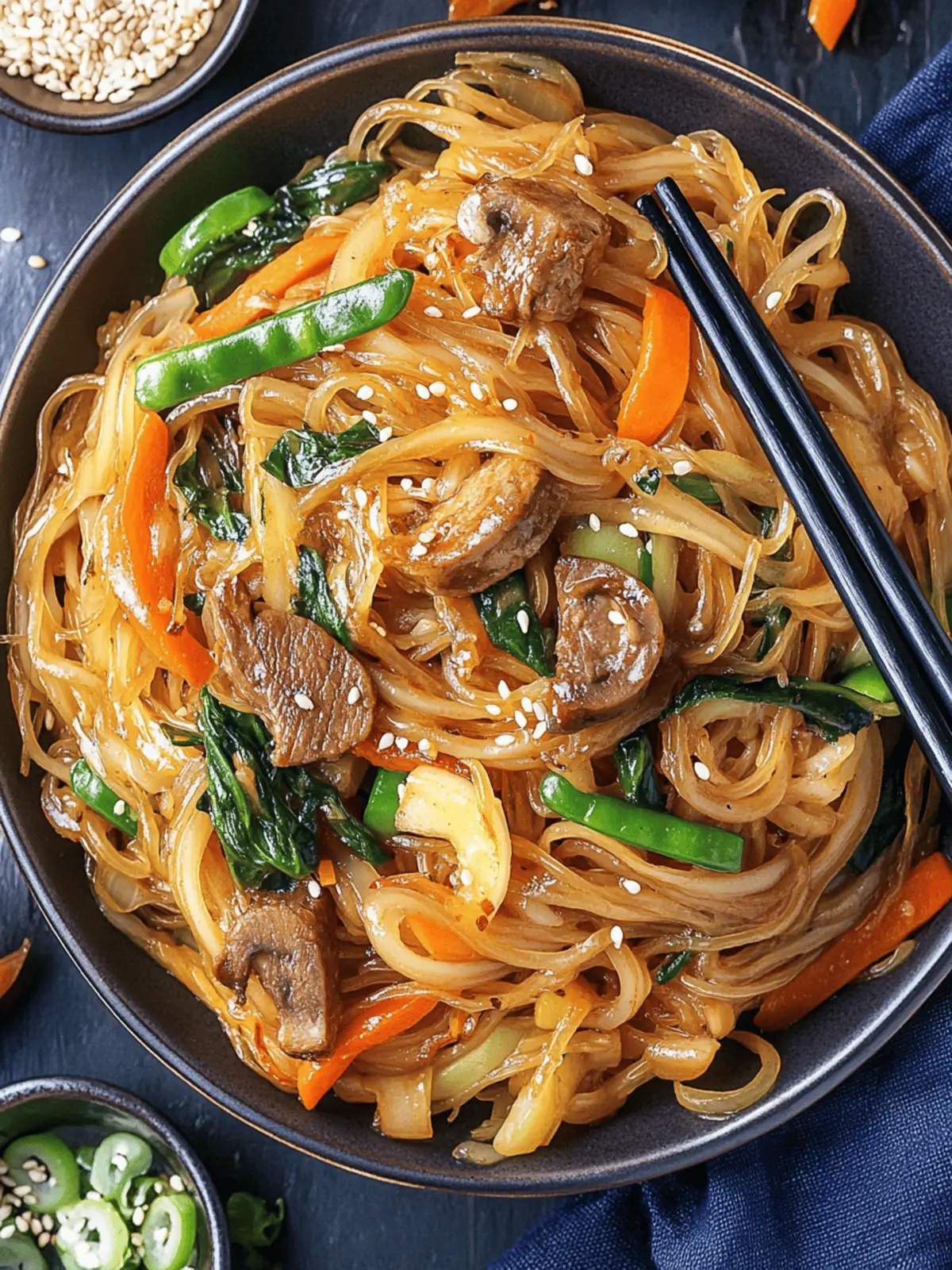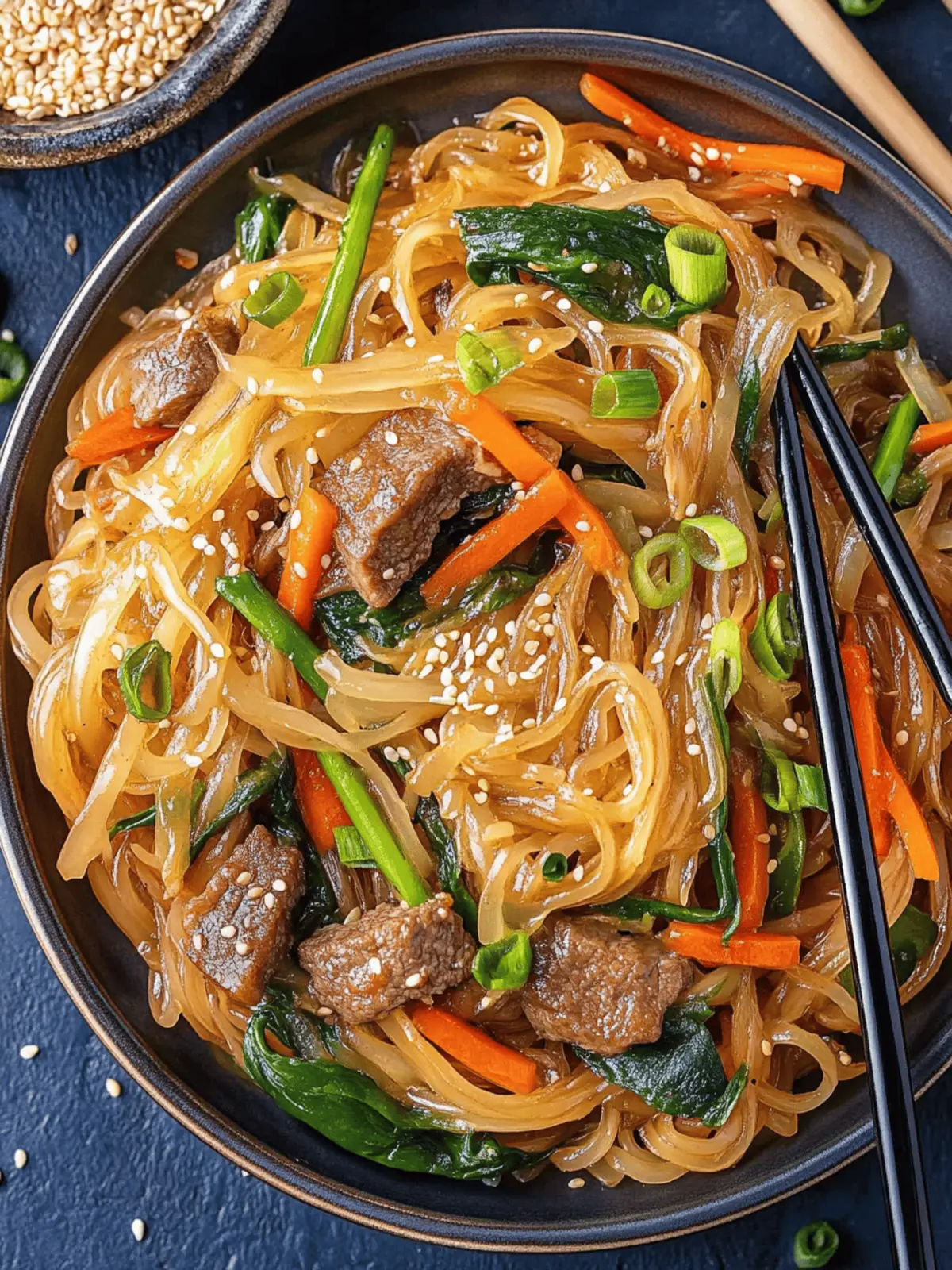When I first tasted Japchae at a cozy little Korean restaurant, the vibrant colors and rich flavors danced together in perfect harmony, leaving me eager to recreate that magic in my own kitchen. This beloved dish, often enjoyed during festive gatherings, is a delightful blend of chewy glass noodles, tender beef, and a medley of vegetables, all brought together by a savory-sweet sauce that’s simply irresistible.
As the seasons change and the hustle and bustle of life takes over, having a reliable recipe like this one on hand is a game-changer. Not only is Japchae a crowd-pleaser at dinner parties, but it’s also an excellent way to use up any leftover veggies in your fridge, making it both nutritious and sustainable.
The beauty of this dish lies in its versatility; feel free to swap in your favorite proteins or veggies, and adjust the spice level to suit your taste. So, let’s dive into this easy-to-follow recipe that will transport you to the bustling streets of Seoul with every delicious bite!
Why is Japchae a Must-Try Recipe?
Simple preparation: With straightforward steps, you’ll impress anyone with your culinary skills without spending hours in the kitchen.
Vibrant colors: The medley of fresh vegetables creates a stunning visual appeal that will brighten up any meal.
Flavor explosion: Each bite is a delightful dance of sweet, savory, and umami notes, thanks to the harmonious sauce.
Customizable delight: Personalize your dish by swapping in different proteins or adding extra veggies, perfect for any dietary preference.
Perfect for gatherings: Serve Japchae at your next dinner party, and watch it disappear as friends and family rave about the flavors!
If you want to extend your culinary skills further, check out our guide on mastering Korean dishes.
Japchae Ingredients
For the Sauce
• Soy sauce or tamari – This key ingredient infuses the Japchae with its rich umami flavor.
• Brown sugar – Adds a hint of sweetness that balances the savory elements.
• Rice vinegar – Brightens the flavors with its tang, enhancing overall taste.
• Toasted sesame oil – Introduces a nutty aroma that elevates the dish.
• Minced garlic – Provides a delicious depth of flavor that no dish should be without.
• Black pepper – Offers a subtle heat that compliments the other ingredients.
• Salt – Enhances all the flavors, ensuring a well-rounded sauce.
• Gochujang or sriracha (optional) – For those who crave a spicy kick, these add a delightful heat.
For the Noodles
• Glass noodles – The star ingredient that brings the dish together with its chewy texture.
For the Beef
• Boneless beef short ribs, thinly sliced – Tender cuts are perfect for absorbing flavor and provide protein.
For the Vegetables
• Carrots – Their natural sweetness adds color and crunch to the dish.
• Red bell pepper – This veggie introduces a lovely hue and fresh taste.
• White onion – Offers a subtle sweetness and depth to the overall flavor profile.
• Button mushrooms – Add an earthy flavor that complements the other ingredients beautifully.
• Green onions – Use both the white and green parts for added freshness and flavor.
• Baby spinach – Not only is it nutritious, but it also wilts perfectly into the dish for a vibrant finish.
For the Eggs
• Large eggs – When cooked, they become a savory addition that adds richness to the Japchae.
To Garnish
• Toasted sesame seeds (optional) – A sprinkle of these adds a delightful crunch and extra flavor.
With these carefully selected Japchae ingredients, you’re on your way to creating an unforgettable dish that’s perfect for any occasion!
How to Make Japchae
-
Whisk together 1 tablespoon of soy sauce, 1 tablespoon of brown sugar, 2 teaspoons rice vinegar, 1 teaspoon sesame oil, ½ teaspoon garlic, and ½ teaspoon black pepper in a large bowl. Add the beef and toss well. Cover and refrigerate for 30 minutes or up to 3 hours for deeper flavor.
-
Combine the remaining 1/3 cup soy sauce, 1 tablespoon brown sugar, 3 teaspoons sesame oil, 1 teaspoon garlic, ½ teaspoon gochujang (if using), ½ teaspoon black pepper, and ½ teaspoon salt in a medium bowl. Set aside.
-
Cook the glass noodles according to package directions. Once cooked, drain in a colander and transfer to a clean, large bowl. Add half of the sauce and toss gently to coat the noodles.
-
Beat the eggs with ¼ teaspoon salt in a small bowl until combined. Heat 1 tablespoon of avocado oil in a large nonstick skillet over medium heat. Add the whisked eggs, swirling the skillet to cover the bottom. Cook undisturbed for 2-3 minutes or until set.
-
Transfer the cooked eggs to a cutting board using two spatulas. Cut the egg circle in half, rotate, and cut into ½-inch wide strips. Toss these egg pieces into the bowl with the noodles.
-
Sauté carrots in 1 tablespoon of avocado oil over medium-high heat for about 3 minutes. Add the bell peppers and onions, cooking for another 2-3 minutes until softened. Transfer all vegetables to the bowl of noodles.
-
Add the remaining 1 tablespoon avocado oil to the skillet. Once heated, include the mushrooms, cooking for 2 minutes. Then, add the white parts of the green onion and the spinach, cooking for another minute until the spinach begins to wilt. Transfer these veggies to the noodles and add the reserved sauce mixture. Toss well.
-
Heat the wok again to a high temperature, and add the marinated beef, shaking off excess marinade. Cook for 5-7 minutes until the beef is cooked through with a nice sear. Transfer the beef to the bowl of noodles and toss gently with everything, then serve topped with the green parts of the green onions and toasted sesame seeds, if desired.
Optional: Garnish with extra toasted sesame seeds for added crunch.
Exact quantities are listed in the recipe card below.
Japchae Variations & Substitutions
Feel free to play around with your Japchae and make it your own with these delightful variations!
- Vegetarian: Substitute beef with tofu or mushrooms for a hearty, meatless dish that’s still deliciously satisfying.
- Noodle Alternative: Use spiralized zucchini or rice for a gluten-free version that packs the same comforting feel without the carbs.
- More Greens: Toss in some bok choy or broccoli for an extra crunch and vibrant color, boosting the nutritional value.
- Heat It Up: Add more gochujang or a pinch of red pepper flakes for a fiery kick that will spice up your meal and awaken your taste buds.
- Nutty Twist: Include crushed peanuts or cashews as a topping for added texture and a nutty flavor that complements the dish beautifully.
- Sweet Swap: For a unique twist, replace half the brown sugar with honey or maple syrup, offering a different layer of sweetness.
- Savory Upgrade: Experiment with different sauces, such as oyster sauce or hoisin, to craft your own flavor profile while still keeping the spirit of Japchae.
- Seasonal Veggies: Make use of any seasonal vegetables you have on hand; snap peas or bell peppers always work nicely, staying true to the dish’s versatility.
With these variations, you can embark on a new culinary journey with each batch of Japchae, bringing excitement to your kitchen table!
Make Ahead Options
These Japchae are fantastic for busy home cooks who want to save time during the week! You can marinate the beef in your sauce for up to 3 hours or even overnight for deeper flavor. Additionally, the glass noodles can be cooked and tossed in half of the sauce, then refrigerated for up to 3 days. Just remember to keep the vegetables separate until you’re ready to stir-fry them for maximum freshness. When you’re ready to serve, simply heat everything together in a wok or skillet, adding the remaining sauce and any fresh ingredients. This way, you’ll enjoy delicious, restaurant-quality Japchae with minimal effort, perfect for those hectic weeknights!
How to Store and Freeze Japchae
Fridge: Store leftovers in an airtight container in the refrigerator for up to 3 days. This helps maintain the flavors while keeping the glass noodles tender.
Freezer: For longer storage, freeze Japchae in a freezer-safe container for up to 2 months. Thaw overnight in the fridge before reheating.
Reheating: Gently reheat in a skillet over medium heat, adding a splash of water or soy sauce to keep the noodles moist and flavorful. Enjoy your homemade Japchae warm!
What to Serve with Japchae?
Indulging in a plate of Japchae is a delightful experience, and pairing it with complementary sides can elevate your meal to new heights.
-
Crispy Spring Rolls: These light, crunchy rolls filled with vegetables offer a delightful contrast to the chewy glass noodles of Japchae.
-
Korean Fried Chicken: The crispy textures and spicy glaze of this iconic dish create a flavor-packed combination that leaves everyone wanting more.
-
Kimchi Salad: This tangy and spicy side adds a refreshing kick that balances the savory sweetness of Japchae beautifully. The crunchy texture intensifies the dining experience.
-
Steamed Dumplings: Juicy and savory, these bite-sized treats are perfect for sharing and pair exceptionally well with the rich flavors of the noodles.
-
Grilled Zucchini: This light and tender vegetable brings fresh flavor to the table, enhancing the dish’s vibrant colors and textures.
-
Chilled Soju Cocktails: The light and refreshing qualities of a chilled cocktail or soju complement the savory notes of Japchae without overwhelming the palate.
-
Traditional Rice: A simple bowl of steamed rice adds a hearty element to the meal, ensuring no flavor is left undiscovered during your dining experience.
-
Sesame Spinach: This dish harmonizes the fresh flavors of baby spinach with a nutty sesame dressing, echoing the beloved tart notes found in Japchae.
Expert Tips for Japchae
Marinate Well: Ensure the beef is marinated for at least 30 minutes, but up to 3 hours for a deeper, richer flavor in your Japchae.
Toss Noodles Gently: When mixing the glass noodles with the sauce, be gentle to avoid breaking them. Over-tossing can lead to mushy noodles.
Veggie Timing: Add vegetables in the order of their cooking time—harder vegetables like carrots first, and softer ones like spinach last—to retain optimal texture and flavor.
Sear the Beef: For the best flavor and texture, don’t overcrowd the pan when searing the beef; cook in batches if necessary to achieve that perfect crust.
Taste as You Go: Always taste and adjust the seasoning towards the end. It’s a great way to customize the independence of the sauce in your Japchae.
Japchae Recipe FAQs
What kind of glass noodles should I use for Japchae?
You should use sweet potato glass noodles (also known as dangmyeon) for the authentic texture and taste that Japchae is famous for. They have a delightful chewy consistency and soak up the flavors beautifully.
How should I store leftover Japchae?
Store leftovers in an airtight container in the refrigerator for up to 3 days. This way, you can enjoy the flavors again while keeping the glass noodles tender. Make sure to let the dish cool before sealing it tightly to prevent condensation.
Can I freeze Japchae?
Absolutely! To freeze Japchae, place it in a freezer-safe container, ensuring it’s sealed well to avoid freezer burn. You can freeze it for up to 2 months. When you’re ready to enjoy it, simply thaw overnight in the fridge and reheat in a skillet over medium heat.
What if my noodles become mushy?
If your glass noodles become mushy, it may be due to overcooking them initially or tossing them too vigorously with the sauce. For future attempts, be sure to cook the noodles according to package instructions and stir them gently with the sauce to preserve their texture.
Is there a vegetarian option for this recipe?
Yes! You can substitute the beef with tofu or tempeh for a plant-based version. Just marinate your choice of protein in the same sauce as you would the beef, and follow the rest of the recipe as usual. This makes a vibrant and satisfying dish while keeping it entirely vegetarian!
Can my dog eat Japchae?
While some ingredients like carrots and spinach are safe for dogs, be cautious with soy sauce and other seasonings, as they can be high in sodium and not good for pets. It’s best to prepare a version for your fluffy friend without those ingredients, ensuring it’s healthy and safe for them!

Delicious Japchae: A Restaurant-Style Dish at Home!
Ingredients
Equipment
Method
- Whisk together 1 tablespoon of soy sauce, 1 tablespoon of brown sugar, 2 teaspoons of rice vinegar, 1 teaspoon of sesame oil, ½ teaspoon of garlic, and ½ teaspoon of black pepper in a large bowl. Add the beef and toss well. Cover and refrigerate for 30 minutes or up to 3 hours for deeper flavor.
- Combine the remaining 1/3 cup soy sauce, 1 tablespoon brown sugar, 3 teaspoons sesame oil, 1 teaspoon garlic, ½ teaspoon gochujang (if using), ½ teaspoon black pepper, and ½ teaspoon salt in a medium bowl. Set aside.
- Cook the glass noodles according to package directions. Once cooked, drain in a colander and transfer to a clean, large bowl. Add half of the sauce and toss gently to coat the noodles.
- Beat the eggs with ¼ teaspoon salt in a small bowl until combined. Heat 1 tablespoon of avocado oil in a large nonstick skillet over medium heat. Add the whisked eggs, swirling the skillet to cover the bottom. Cook undisturbed for 2-3 minutes or until set.
- Transfer the cooked eggs to a cutting board using two spatulas. Cut the egg circle in half, rotate, and cut into ½-inch wide strips. Toss these egg pieces into the bowl with the noodles.
- Sauté carrots in 1 tablespoon of avocado oil over medium-high heat for about 3 minutes. Add the bell peppers and onions, cooking for another 2-3 minutes until softened. Transfer all vegetables to the bowl of noodles.
- Add the remaining 1 tablespoon avocado oil to the skillet. Once heated, include the mushrooms, cooking for 2 minutes. Then, add the white parts of the green onion and the spinach, cooking for another minute until the spinach begins to wilt. Transfer these veggies to the noodles and add the reserved sauce mixture. Toss well.
- Heat the wok again to a high temperature, and add the marinated beef, shaking off excess marinade. Cook for 5-7 minutes until the beef is cooked through with a nice sear. Transfer the beef to the bowl of noodles and toss gently with everything, then serve topped with the green parts of the green onions and toasted sesame seeds, if desired.








